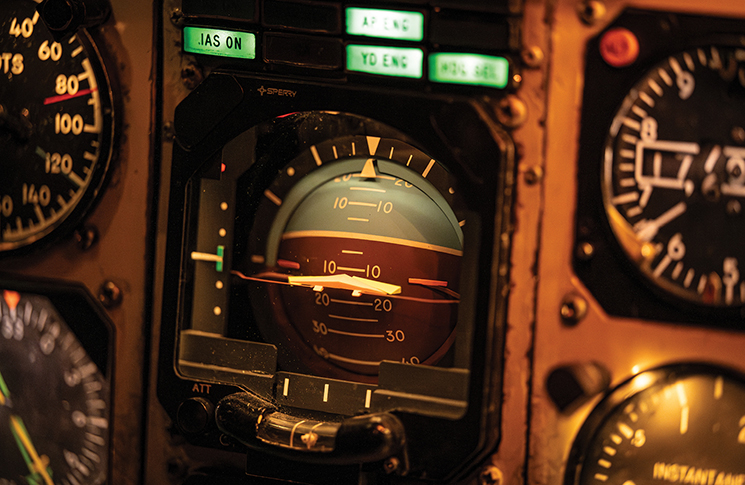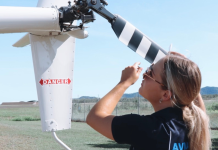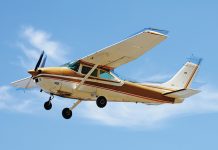The Wright brothers are universally known in aviation for the first powered flight of the Wright Flyer in December 1903. Only 11 years later, a lesser-known aviation pioneer, Lawrence Sperry, demonstrated his father’s invention – a gyroscopic autopilot – at an aviation safety contest held in Paris.
In front of a grandstand comprised of both the general public and top military brass, Sperry made his first pass of the grandstand with his hands clearly above the cockpit of his Curtis C-2 biplane.
On the second pass his assistant, Emil Cachin, climbed out onto the wing and again, with Sperry’s hands clearly not on the controls, the aircraft remained level. As if not impressive enough, on a third pass, Sperry extricated himself from the cockpit and leisurely made his way onto the opposite wing, leaving the controls completely unattended. Naturally, the crowd was amazed.
In World War II the autopilot acquired a name. Allied bomber, patrol and transport crews called it George, as though it were an extra member of the crew. More than 100 years since Sperry, a George is a near standard piece of equipment in almost all aircraft in production. It’s now commonplace to see modern, digital autopilots in even recreational aircraft. A two-seat light sport aircraft today may have a more capable autopilot than a small airliner did 30 years ago.
New technology sometimes creates as many problems as it solves – the challenge introduced by reliable modern autopilots lies less in the equipment itself and more in the pilot operating it. Misunderstanding what an autopilot can and cannot do has been a contributing factor in numerous fatal accidents, both in Australia and overseas. Understanding these limitations should be the starting point for transitioning to an aircraft with these systems.
Understand the capabilities of your equipment
The range of autopilot equipment in GA aircraft remains immense. On one end of the scale, I still routinely encounter light aircraft with Century II and Century III autopilots – late 1970s technology, limited to more basic modes like pitch, roll, heading and altitude modes. The reliability of these units is becoming increasingly questionable as they continue to age. The challenge with these units can be just getting them to consistently work (and having enough money to pay your LAME to fix them).
On the other hand, modern digital autopilots like the Garmin GFC 500, 600 and 700 are common equipment on even training aircraft, and are often capable of complete integration with flight display and navigation systems. Indicated airspeed and vertical speed modes, along with the ability to conduct coupled 3D approaches, put these units on a par with many airliners, introducing complexity alongside capability.

At both ends of the scale, the starting point is always understanding what your system is capable of. There’s the obvious stuff – what modes can it operate in? How do I turn it on? Can I couple it with other equipment such as a GPS? The aircraft flight manual (or the supplement for the autopilot) will help you here, as will some time with a flight instructor familiar with the system.
But there are some other capabilities of autopilots that really need to be understood. I want the answers to 3 questions before flying an unfamiliar aircraft or autopilot:
Can the autopilot manipulate any of the trim systems?
Although some autopilots can run the trim on the elevator, rudder and aileron, many simple autopilots don’t have this feature. Where this is the case, the pilot must manually trim out control forces before engaging the autopilot.
If the aircraft is out of trim, the autopilot may still be capable of operating but may also display a signal to the pilot that the aircraft is out of trim. Autopilot trim motors have been the cause of trim runaways, where a trim motor runs uncommanded continuously.
What happens if I try to overpower the autopilot? Will it trim against my inputs?
In 2015, a student pilot conducting a solo navigational flight in a Cessna 172S was fatally injured after colliding with terrain east of Ballarat, Victoria. The subsequent ATSB investigation revealed the pilot had likely manipulated the controls with the autopilot engaged, unaware that the autopilot would re-trim the aircraft against their control inputs. When the autopilot eventually disconnected, the pilot was handed the aircraft in a severe nose-down trim condition, leading to a rapid descent that was not recovered from.
Many flight schools now disable autopilot capability for pre-PPL solo sequences, but understanding all the equipment in your aircraft remains part of the training syllabus for all levels of licence.
When the autopilot eventually disconnected, the pilot was handed the aircraft in a severe nose-down trim condition.
Can the autopilot remain engaged during flap or gear selection?
Older autopilots often prohibit use while extending flap, most often to prevent an autopilot from hiding an asymmetric flap condition as it occurs.
Older Piper PA31 Navajo/Chieftain aircraft with a UP/OFF/DOWN flap selector are an example of this. These older flap systems have no inbuilt protection against asymmetry and by requiring the pilot to remain in the loop while extending flap, they’re able to identify any asymmetry and potentially stop the flap motor before the aircraft is uncontrollable.
Flight director versus autopilot
The flight director and autopilot are frequently part of the same system, but they do distinctly different things. One is brains, one is brawn.
The flight director determines the attitude to be flown – it is brains. Normally displayed as an overlay on the attitude indicator, the flight director can tell the autopilot (or the regular pilot) which pitch and roll attitude will keep or return the aircraft to the desired performance.

The autopilot is simply the mechanism that manipulates the controls to achieve the attitude commanded by the flight director – it is brawn. Usually, a series of servo motors manipulate the elevator, aileron and (sometimes) rudder, along with sometimes being able to run trim motors.
Most mode control panels will only activate flight director when you select a mode, for example, heading or vertical speed, but it’s not until the autopilot button is pressed that the system begins controlling the aircraft.
Be disciplined in how you engage the autopilot
Engaging the autopilot often first occurs on the climb out after take-off – generally a high workload phase of flight. You may need to do it while managing other threats such as traffic, ATC or weather. Having a consistent and disciplined approach to activating the autopilot ensures the correct modes are selected before engagement, without pulling attention away from flying the aircraft while you do.
I teach students the following method for most smaller aircraft with a digital autopilot and flight director:
- select lateral and vertical flight director modes on the mode control panel
- verify in the flight mode annunciator (FMA) panel that the selected mode matches what you intended
- verify that the flight director bars on your attitude indicator match your current or intended attitude
- engage the autopilot and verify engagement on the FMA.
By choosing the flight director mode before engaging the autopilot, you guard against inadvertently selecting the wrong mode. If it is already engaged, the autopilot immediately follows the commands from the incorrect mode, forcing you to disengage the autopilot and regain control.
If automation doesn’t behave as intended, it’s important to return to aviating before trying to troubleshoot your uncooperative autopilot system.
Know how to turn it off
It seems obvious, but knowing how to turn your autopilot off is critical. If the aircraft under autopilot is doing something you don’t want it to, you need to know how to quickly regain control. If this happens, you will be in a high workload situation as you fight for control over the aircraft while trying to disable the autopilot. Often there’s a big red disconnect button on the yoke, but what if that fails to stop the autopilot?
Most aircraft have at least 5 avenues to disconnect the autopilot:
- pressing the AP button on the mode control panel
- pressing an AP disconnect button on the flight controls
- operating the electric trim
- opening (pulling) the AP circuit breaker
- turning off the avionics or battery master switches – clearly a last resort.
The other half of the equation is knowing when the autopilot will turn itself off. On most newer systems, the stall warning will trigger an autopilot disconnect, to try to prevent the autopilot from holding the aircraft into a stall and possible spin. Other systems may also be able to trigger disengagement, such as loss of attitude or heading reference.
It is worth understanding how an uncommanded disconnect will look, sound and feel. On older systems the disconnect may not be announced at all. If you’re lucky, you might hear the switch flick but short of that, you may not actually notice until the attitude begins to diverge from the intended path.
Newer systems will have an intuitive audible disconnect alarm but on an uncommanded disconnect, this alarm may sound continuously until you press the AP disconnect button to acknowledge it.
Know when to disconnect
In April 1997, Warren ‘Van’ Vanderburgh delivered a presentation to students at the American Airlines Flight Academy, titled ‘Children of the magenta line’.
The title is a facetious reference to the colour of the flight director bars and course deviation indicator, and a warning against blind overreliance on automation such as EFBs or ‘just following the magenta line’.
His presentation which is available online, became an authority on how to safely manage automation on aircraft that, at the time, were becoming increasingly computer-driven.
One of the key messages of his presentation is that knowing when to decrease the level of – or completely disconnect – automation is almost as important as knowing how to use it. Vanderburgh was a training captain on the Boeing 757, 767 and 777 and had seen many captains and first officers struggle with this during line operations.
It seems obvious, but knowing how to turn your autopilot off is critical.
He offers several examples of high workload situations, such as during an approach where an aircraft on autopilot (which is following data from the flight management system (FMS)) was given unexpected changes to the arrival at short notice. This could be a standard instrument arrival procedure that is changed to a visual approach or a last-minute change of runway.
Vanderburgh cites one line from an incident as being the best indicator that it’s probably time to turn the autopilot off – ‘What’s it doing now?’
In each example, although the narrative is different, Vanderburgh almost comically acts out his take on the typical pilot response – immediately going head down into the FMS, furiously typing inputs into the scratchpad on the computer, rather than simply disconnecting the autopilot and flying the aircraft. In each case situational awareness was lost.
Great responsibility
Lawrence Sperry would have had a hard time imagining how much his invention would develop in the 100 years since first demonstrating the autopilot to the world. I’m not sure if I quite trust the autopilot enough to leave the controls mid-flight (or walk out on the wing), but there’s no denying that the tools we have today are powerful.
I run a handful of Cessna 208 Caravan initial type training courses each year. Of the nearly 600 pages in the manual for the Garmin G1000NXi (the avionics package for later model Caravans), the autopilot section alone is more than 40 pages. There’s so much to know, and it’s no better on any of the smaller types with similar systems.
One of the hardest things in aviation is identifying what it is that you don’t know. Hopefully this article has helped you identify something about your aircraft’s autopilot that you don’t yet fully understand. Of course, the great responsibility that leaves you with, is filling in that knowledge gap.





